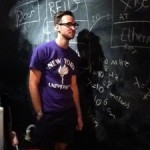Undergraduates in the Archives – Gotkin 1
By
Kevin Gotkin
February 2012
1How have you worked with undergraduates in archives and/or special collections?
Kevin Gotkin
BA in Media, Culture, and Communication, Class of 2011 – NYU
PhD Student, Annenberg School for Communication – University of Pennsylvania
¶ 1 Leave a comment on paragraph 1 0 A few years ago, I was an undergraduate in the archive. In a class called “Dead Media Research Studio” at New York University (NYU), Professor Ben Kafka introduced me to the great quip about the chiasmic imperative of good research: to “make the familiar strange and the strange familiar.” With this echoing in my ears, I found myself in the entrails of Bobst Library interviewing two preservation specialists about a small but intriguing collection of wire recordings. The recordings, I found out, were of rather unknown origins in the early 1950s and contained some controversial tirades against President Truman. Though certainly not an exhaustive archive, the recordings provided me with my first meaningful interaction with historical primary sources. And it was a rather lonely endeavor; the hallways leading to troves of under-researched sources were woefully empty compared to the bustling study lounges located just a few floors above.
¶ 2
Leave a comment on paragraph 2 0
My research on wire recordings ended up as part of a dossier (similar to the format and scope of a Wikipedia entry) I wrote with two classmates for the Dead Media Archive. Professors Ben Kafka and Alex Galloway had rescued this archive from its own ironic demise as an e-mail list created by Bruce Sterling to catalog and describe obsolete technologies. The new Dead Media Archive, technically a wiki platform for simultaneous publishing and editing, became the centerpiece for two classes in the Department of Media, Culture, & Communication (one undergraduate and one graduate). The semester in which I took the class, there were barely ten students enrolled. It puzzled me a bit, since Professor Kafka announced on the first day what every undergraduate seems to dream of hearing: there would be no exams, no papers, and very little reading. Instead, we were to be immersed in the city’s archives for a semester. Each student ended up producing three dossiers for the archive. In addition to one on wire recording, I also wrote an entry on spirit photography, a popular turn-of-the-century practice of “capturing” ghosts on film, which was accompanied by the rise of Spiritualism. A sizeable portion of my hard drive is still taken up by copies of the microform proceedings of the 1869 trial against William Mumler, a New York City spirit photographer accused of fraud (see Figure 1). My final dossier presented a more argumentative take on the “death” of media by cataloging marginalia, the scribbles in a text’s margins, as obsolete relics of a technological paradigm. Figure 1: Microform copy of the proceedings of a 1869 court case against spirit photographer William Mumler.
Figure 1: Microform copy of the proceedings of a 1869 court case against spirit photographer William Mumler.
¶ 3 Leave a comment on paragraph 3 0 Before arriving at NYU, I would have scoffed at the idea of studying media history. There was much sighing on my first day in the required “History of Communication” course; I imagined, like many fellow undergraduates, that a degree in media studies would help me land a job in New York’s radio, television, or film industries. History, for us, was a roadblock in the path to careers less concerned with the past than with the frenetic present. The thrill of finding primary sources changed my mind. In the archive, I realized the opportunity to conduct original research. The excitement of archival work is shared by undergraduates, graduate students, and faculty alike; it is the thrill of finding something that has not been thought about enough, and then working hard enough to make it both familiar and strange.


0 Comments on the whole post
Leave a comment on the whole post
0 Comments on paragraph 1
Leave a comment on paragraph 1
0 Comments on paragraph 2
Leave a comment on paragraph 2
0 Comments on paragraph 3
Leave a comment on paragraph 3